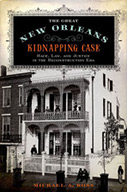The Great New Orleans Kidnapping Case: Race, Law, and Justice in the Reconstruction Era

Author: Michael A. Ross
Publisher: Oxford, UK: Oxford University Press, 2015. 320p.
Reviewer: Jonathan Lurie | November 2015
At the outset, "truth in advertising" requires this reviewer to acknowledge that more than a decade ago he and his co-author presented a study in micro history, also of a land mark case arising out of New Orleans at just about the same time as the litigation so brilliantly delineated here by Michael Ross. Both books, to paraphrase William Blake, sought "to see a world in a grain of sand,” and while comparisons are not appropriate here, Ross has succeeded to a remarkable extent in producing a tale replete with local, state and federal implications and insights into the national tragedy that became Reconstruction. Each of these three locales intersects with the others, and as his study concludes, he explains not only what happened to Reconstruction in New Orleans and Louisiana as well as the former Confederacy, but also why it happened and, finally, what might have occurred. It should be stated that this book makes for superb reading.
Ross begins his book with a description of the Crescent City in 1870, at the height of Reconstruction–a dank, humid environment characterized by criminal violence amid palpable racial and political tensions. Whites, many of them ex confederates, lived there–and resented demands by newly freed former slaves for equal service in restaurants and similar establishments. Moreover, they could now run for office, hold government jobs, and serve on juries. The New Orleans police force had been integrated at the behest of the 28-year old Republican governor Henry Clay Warmoth, probably the youngest such official in state–if not national history. When seventeen month old Mollie Digby, daughter of Irish immigrants was kidnapped on June 9, 1870, apparently by two Afro-Creole women, the police chief assigned a Creole detective to investigate the case. Ross skillfully narrates its developments, culminating in the return of Mollie to her parents exactly two months later. Yet this incident is but the beginning of Ross’s study. The remainder of his book deals with the apprehension and trial of the two Afro-Creole sisters accused in the kidnapping, in the context of militant white insistence that nothing good could result from local Republican political control, matched by a dogged determination to see such misplaced authority ended.
Ross leads the reader through the arrests of Louisa Murray and Ellen Follin, and their appearance before what was known as the Recorder’s Court, a tribunal in which the presiding judge had to determine whether the case before him should be sent on to a grand jury and the 1st District Criminal Court for a full trial. He explains why both municipal and state officials attached great importance to the prosecutor’s case. A conviction "might also help convince white Louisianans that the Reconstruction government’s judicial system dispensed punishments equally to both races" (108). With the Democratic press demanding conviction and a harsh penalty for the two defendants, not only the two sisters, but also the recently integrated Metropolitan Police force and the tactics they had employed were under critical public scrutiny, already intensified due to the kidnapping incident.
Although several witnesses had previously identified the sisters to police, during the actual trial in the Recorder’s Court, they were less than certain. Moreover, the lead detective, himself a Creole, frankly admitted that he had bullied, lied, and threatened one of the defendants in an effort to entrap her. The prosecutor sought to re-examine this witness, and asked "Why didn’t you tell me about the threats on the direct examination?" Detective Jourdain replied "Because you didn’t ask me" (132). This interchange, in which the prosecutor ended up treating Jourdain as a hostile witness, can only have unsettled whites "already uneasy with black leaders asserting political autonomy,” and black citizens participating in white establishments, including courts. Further, while the suspects had been arrested and bound over for presentation before a grand jury, the Democratic press had nothing positive to say about the local judicial process, thus far.
Because the grand jurors had access to the transcript of the hearing before the Recorder’s Court, and because a number of witnesses repeated their earlier testimony–the sixteen members did not gain much that was new about the kidnapping. In composition, the grand jury was integrated with at least four of them being black. While the state failed to establish a motive for the kidnapping, let alone produce any ransom demand, prosecutors must have been persuasive. At least twelve members handed up an indictment, but whether or not the black members so voted remains unclear.
One of the strengths of this book is that Ross succeeds very well in establishing the contexts in which the case evolved. Before the formal trial got underway in January 1871, state elections had been held. While the Louisiana Republicans managed to keep their majority in the legislature, three former confederate states already had been "redeemed," and were now controlled by the Democrats. Governor Warmoth understood that unless a substantial number of white voters supported his programs, as well as his insistence that bi-racial government was effective and beneficial to all, the future of the local Republicans appeared bleak. Given the great interest aroused by the Digby case, strong support for the prosecution seemed essential. As had been true of the grand jury, the trial jury was also integrated. It contained two Afro-Creole members.
Even as the citizenry celebrated the first evening of Mardi Gras, they anticipated the appearances of the three witnesses who had positively identified Louisa Murray as the woman who had kidnapped Mollie Digby. Their testimony was key to the prosecution’s case, for it had been unable to establish any sort of motive for the "crime," and thus far nothing new had been presented. But the evidence they offered proved more unsatisfactory than the earlier proceeding. One of the three stated that "she was less certain" than she had been earlier that Murray had abducted Mollie. After cross examination, a second witness emerged as both an "unreliable witness–and possible perjurer” (192-193). This left only Mollie’s older brother George who had been with her when she was kidnapped. Ultimately, he admitted that he had been "influenced and prompted by his father to identify Murray."
Lawyers for the defendants called four black neighbors who had observed the kidnapping, and each of them positively stated that Murray and Follin were not the women they noticed. Indeed, they had approached the chief of police, and informed him, but that official had ignored their statements–reflecting a long established New Orleans tradition "of policemen discounting black eyewitnesses, particularly if they were female and illiterate," as was the case here. Further, the witnesses pointed to obvious physical differences between the woman they described and the defendant. Defense counsel also summoned a string of white witnesses who were prepared to testify as to the good character of Murray and Follin. But after four out of the seven had testified, counsel for the defendants suddenly rested their case, and proposed to omit closing arguments, if the prosecutor would agree to do the same. He did, and with only eight minutes of deliberation the jury returned a verdict of not guilty.
Ross observes that the acquittal came "to the great surprise of many observers," and adds that "inexplicably, the newspapers and the court reporter failed to note the reaction to the verdict” (204-205). To the contrary. one possible explanation for this failure comes to mind, and it arises from the care with which Ross has recounted the case and the several legal procedures. Given the thoroughness of his examination, one could conclude that from a contemporary legal perspective, the outcome in the Digby case was not unexpected. To be sure, the tensions of Reconstruction in Louisiana may have been unusual, but in New Orleans the legal system functioned just as it should have. No motive was ever put forth for the kidnapping, and defense counsel had raised substantial doubts concerning the strength of the state’s case. Taken together, these two factors pointed towards an acquittal.
On the other hand, had the case gone forward immediately after the war, with ex confederates in control and the "Black Codes" in effect, the outcome might have been very different. Ross is correct to call Reconstruction "such a pivotal moment in the history of American politics and race relations." In 1870-1871, the Digby case pointed to what was still possible: "that the rigid and often rigged justice of the Jim Crow era was not inevitable, and that the minds of many white New Orleanians had not yet closed to the idea of legal justice for all." But with the collapse of the Southern states’ economies, with expansion rather than elimination of organizations such as the KKK, with local Republican governments reduced to bitter infighting, the results would be all too clear after 1877. In retrospect, one might question Ross’s description of the Digby case’s outcome as "surprising." It only looks that way in the context of the path of Southern history after Rutherford Hayes became President. Again, it was not inevitable that such a path had to be followed.
Although Ross has written a narrative that can stand alone, in a real sense, he saved the best for last. In a fascinating part of a concluding chapter appropriately entitled "Afterward," he explains how he first came across the Digby case, the twists and turns where his resulting research ultimately brought him, including getting well acquainted with some living descendants of the original litigation and its aftermath. Indeed, Ross’s account here is of as great an interest as his own historical study on which he has based this very impressive book. His book tells us about an episode long forgotten, but one which points to what could have been–as well as what actually took place. He is to be congratulated.
Jonathan Lurie, Professor of History Emeritus, Rutgers University


